Synthesis of Carbonaceous Hydrophobic Layers through a Flame Deposition Process
Abstract
:1. Introduction
2. Materials and Methods
3. Results
3.1. Carbon Deposits Formed in CME/Air and CH4/Air Flames
3.1.1. CME/Air Flame
3.1.2. CH4/Air Flame
3.2. C-Layers Formed in CME/Oxygen-Enriched Air Flames
4. Discussion
5. Conclusions
Author Contributions
Funding
Institutional Review Board Statement
Informed Consent Statement
Data Availability Statement
Acknowledgments
Conflicts of Interest
References
- Whyman, G.; Bormashenko, E. How to make the Cassie wetting state stable? Langmuir 2011, 27, 8171–8176. [Google Scholar] [CrossRef] [PubMed]
- Bormashenko, E.; Bormashenko, Y.; Whyman, G.; Pogreb, R.; Stanevsky, O. Micrometrically scaled textured metallic hydrophobic interfaces validate the Cassie-Baxter wetting hypothesis. J. Colloid Interface Sci. 2006, 302, 308–311. [Google Scholar] [CrossRef] [PubMed]
- Gao, L.; McCarthy, T.J. The “lotus effect” explained: Two reasons why two length scales of topography are important. Langmuir 2006, 22, 2966–2967. [Google Scholar] [CrossRef] [PubMed]
- Wang, D.; Sun, Q.; Hokkanen, M.J.; Zhang, C.; Lin, F.Y.; Liu, Q.; Zhu, S.-P.; Zhou, T.; Chang, Q.; He, B.; et al. Design of robust superhydrophobic surfaces. Nature 2020, 582, 55–59. [Google Scholar] [CrossRef]
- Wenzel, R.N. Resistance of solid surfaces to wetting by water. Ind. Eng. Chem. 1936, 28, 988–994. [Google Scholar] [CrossRef]
- Cassie, A.B.D.; Baxter, S. Wettability of porous surfaces. Trans. Faraday Soc. 1944, 40, 546–551. [Google Scholar] [CrossRef]
- Patankar, N.A. Mimicking the lotus effect: Influence of double roughness structures and slender pillars. Langmuir 2004, 20, 8209–8213. [Google Scholar] [CrossRef]
- Yin, Q.; Guo, Q.; Wang, Z.; Chen, Y.; Duan, H.; Cheng, P. 3D-printed bioinspired Cassie-Baxter wettability for controllable microdroplet manipulation. ACS Appl. Mater. Interfaces 2021, 13, 1979–1987. [Google Scholar] [CrossRef]
- Chermahini, S.H.; Ostad-Ali-Askari, K.; Eslamian, S.; Singh, V.P. Recent progress in self-cleaning materials with different suitable applications. Am. J. Eng. Appl. Sci. 2018, 11, 560–573. [Google Scholar] [CrossRef]
- Faustini, M.; Nicole, L.; Boissière, C.; Innocenzi, P.; Sanchez, C.; Grosso, D. Hydrophobic, antireflective, self-cleaning, and antifogging sol-gel coatings: An example of multifunctional nanostructured materials for photovoltaic cells. Chem. Mater. 2010, 22, 4406–4413. [Google Scholar] [CrossRef]
- Chang, K.-C.; Hsu, M.-H.; Lu, H.-I.; Lai, M.-C.; Liu, P.-J.; Hsu, C.-H.; Ji, W.-F.; Chuang, T.-L.; Wei, Y.; Yeh, J.-M.; et al. Room-temperature cured hydrophobic epoxy/graphene composites as corrosion inhibitor for cold-rolled steel. Carbon 2014, 66, 144–153. [Google Scholar] [CrossRef]
- Ozcan, S.; Kaner, P.; Thomas, D.; Cebe, P.; Asatekin, A. Hydrophobic antifouling electrospun mats from zwitterionic amphiphilic copolymers. ACS Appl. Mater. Interfaces 2018, 10, 18300–18309. [Google Scholar] [CrossRef] [PubMed]
- Suk, J.W.; Cho, J.H. Capillary flow control using hydrophobic patterns. J. Micromech. Microeng. 2007, 17, N11–N15. [Google Scholar] [CrossRef]
- Chen, K.; Sun, T. Effects of microstructure design on aluminum surface hydrophobic and ice-retarding properties: Microstructure design on material hydrophobicity. Asia-Pac. J. Chem. Eng. 2017, 12, 307–312. [Google Scholar] [CrossRef]
- Vandencasteele, N.; Merche, D.; Reniers, F. XPS and contact angle study of N2 and O2 plasam-modified PTFE, PVDF and PVF surfaces. Surf. Interface Anal. 2006, 38, 526–530. [Google Scholar] [CrossRef]
- Jiang, L.; Zhao, Y.; Zhai, J. A lotus-leaf-like superhydrophobic surface: A porous microsphere/nanofiber composite film prepared by electrohydrodynamics. Angew. Chem. Int. Ed. 2004, 43, 4338–4341. [Google Scholar] [CrossRef]
- Crick, C.R.; Ismail, S.; Pratten, J.; Parkin, I.P. An investigation into bacterial attachment to an elastomeric superhydrophobic surface prepared via aerosol assisted deposition. Thin Solid Films 2011, 519, 3722–3727. [Google Scholar] [CrossRef]
- Popovicheva, O.; Persiantseva, N.M.; Shonija, N.K.; DeMott, P.; Koehler, K.; Petters, M.; Kreidenweis, S.; Tishkova, V.; Demirdjian, B.; Suzanne, J. Water interaction with hydrophobic and hydrophilic soot particles. Phys. Chem. Chem. Phys. 2008, 10, 2332–2344. [Google Scholar] [CrossRef]
- Esmeryan, K.D.; Gyoshev, S.D.; Castano, C.E.; Mohammadi, R. Anti-frosting and defrosting performance of chemically modified super-nonwettable carbon soot coatings. J. Phys. D Appl. Phys. 2021, 54, 015303. [Google Scholar] [CrossRef]
- Merchan-Breuer, D.; Murphy, E.; Berka, B.; Echeverria, E.; McIlroy, D.N.; Merchan-Merchan, W. Biodiesel flames as a unique pyrolyzing source for the synthesis of hydrophobic carbon films. Carbon Lett. 2021, 31, 389–406. [Google Scholar] [CrossRef]
- Yang, L.; Fu, H.; Yang, C.; Tian, W.; Wu, P.; Jiang, W. Carbon soot with arbitrary wettability deposited on solid surface by ethanol flame method. Colloids Surf. A Physiochem. Eng. Asp. 2019, 578, 123576. [Google Scholar] [CrossRef]
- Esmeryan, K.D.; Castano, C.E.; Mohammadi, R.; Lazarov, Y.; Radeva, E.I. Delayed condensation and frost formation on superhydrophobic carbon soot coatings by controlling the presence of hydrophilic active sites. J. Phys. D Appl. Phys. 2018, 51, 055302. [Google Scholar] [CrossRef]
- Wan, C.; Lu, Y.; Jiao, Y.; Jin, C.; Sun, Q.; Li, J. Fabrication of hydrophobic, electrically conductive and flame-resistant carbon aerogels by pyrolysis of regenerated cellulose aerogels. Carbohydr. Polym. 2015, 118, 115–118. [Google Scholar] [CrossRef]
- Cao, H.; Fu, J.; Liu, Y.; Chen, S. Facile design of superhydrophobic and superoleophilic copper mesh assisted by candle soot for oil water separation. Colloids Surf. A Physiochem. Eng. Asp. 2018, 537, 294–302. [Google Scholar] [CrossRef]
- Shen, L.; Wang, W.; Ding, H.; Guo, Q. Flame soot stably deposited on silicone coating possess superhydrophobic surface. Appl. Surf. Sci. 2013, 284, 651–656. [Google Scholar] [CrossRef]
- Naha, S.; Sen, S.; Puri, I.K. Flame synthesis of superhydrophobic amorphous carbon surfaces. Carbon 2007, 45, 1702–1706. [Google Scholar] [CrossRef]
- Mansurov, Z.A.; Nazhipkyzy, M. Flame Synthesis of Superhydrophobic Carbon Surfaces. Available online: http://www.kinetics.nsc.ru/kcp/9ISFS/Proceedings/Mansurov.pdf (accessed on 29 January 2022).
- Zulfiqar, U.; Hussain, S.Z.; Subhani, T.; Hussain, I.; Habib-ur-Rehman. Mechanically robust superhydrophobic coating from sawdust particles and carbon soot for oil/water separation. Colloids Surf. A Physiochem. Eng. Asp. 2018, 539, 391–398. [Google Scholar] [CrossRef]
- Mazumder, S.; Ghosh, S.; Puri, I.K. Non-premixed flame synthesis of hydrophobic carbon nanostructured surfaces. Proc. Combust. Inst. 2011, 33, 3351–3357. [Google Scholar] [CrossRef]
- Xiao, L.; Zeng, W.; Liao, G.; Yi, C.; Xu, Z. Thermally and chemically stable candle soot superhydrophobic surface with excellent self-cleaning properties in air and oil. ACS Appl. Nano Mater. 2018, 1, 1204–1211. [Google Scholar] [CrossRef]
- Sung, Y.H.; Kim, Y.D.; Choi, H.J.; Shin, R.; Kang, S.; Lee, H. Fabrication of superhydrophobic surface with nano-in-micro structures using UV-nanoimprint lithography and thermal shrinkage films. Appl. Surf. Sci. 2015, 349, 169–173. [Google Scholar] [CrossRef]
- Santoro, R.J.; Yeh, T.T.; Horvath, J.J.; Semerjian, H.G. The transport and growth of soot particles in laminar diffusion flames. Combust. Sci. Technol. 1987, 53, 89–115. [Google Scholar] [CrossRef]
- Merchan-Merchan, W.; Sanmiguel, S.G.; McCollam, S. Analysis of soot particles derived from biodiesels and diesel fuel air-flames. Fuel 2012, 102, 525–535. [Google Scholar] [CrossRef]
- Merchan-Merchan, W.; Abdihamzehkolaei, A.; Merchan-Breuer, D.A. Formation and evolution of carbon particles in coflow diffusion air flames of vaporized biodiesel, diesel and biodiesel-diesel blends. Fuel 2018, 226, 263–277. [Google Scholar] [CrossRef]
- Merchan-Merchan, W.; McCollam, S.; Pugliese, J.F.P. Soot formation in diffusion oxygen-enhanced biodiesel. Fuel 2015, 156, 129–141. [Google Scholar] [CrossRef] [Green Version]
- Lee, K.O.; Megaridis, C.M.; Zelepouga, S.; Saveliev, A.V.; Kennedy, L.A.; Charon, O.; Ammouri, F. Soot formation effects of oxygen concentration in the oxidizer stream of laminar coannular nonpremixed methane/air flames. Combust. Flame 2000, 121, 323–333. [Google Scholar] [CrossRef]
- Xu, L.; Wang, Y.; Liu, D. Effects of oxygenated biofuel additives on soot formation: A comprehensive review of laboratory-scale studies. Fuel 2021, 313, 122635. [Google Scholar] [CrossRef]
- Saito, K.; Williams, F.A.; Gordon, A.S. Effects of oxygen on soot formation in methane diffusion flames. Combust. Sci. Technol. 1986, 47, 117–138. [Google Scholar] [CrossRef]
- Merchan-Merchan, W.; Sanmiguel, S.; Saveliev, A.; McCollam, S. Soot formation in oxygen-enhanced combustion. In Oxygen-Enhanced Combustion, 2nd ed.; Baukal, C.E., Jr., Ed.; CRC Press: Boca Raton, FL, USA, 2013; pp. 385–408. [Google Scholar]
- Silva, L.C.P.; Wilfinger, M.M.; Murari, T.B.; Filho, A.S.N.; Moret, M.A.; Santos, A.A.B. Experimental evaluation of thermal radiation and soot concentration rates for syngas flames in lean condition and oxygen enhanced combustion. Energy Rep. 2021, 7, 4139–4145. [Google Scholar] [CrossRef]
- Beltrame, A.; Porshnev, P.; Merchan-Merchan, W.; Saveliev, A.; Fridman, A.; Kennedy, L.; Petrova, O.; Zhdanok, S.; Almouri, F.; Charon, O. Soot and NO formation in methane-oxygen enriched diffusion flames. Combust. Flame 2001, 124, 295–310. [Google Scholar] [CrossRef]
- Baukal, C.; Abdihamzehkolaei, A.; Jimenez, W.C.; Saveliev, A.V.; Merchan-Merchan, W. Flow visualization in an oxy-fuel counter-flow burner. In A Gallery of Combustion and Fire; Baukal, C., Jr., Agarwal, A., Olson, S., Gollner, M., Jacobs, T., Vaccari, M., Eds.; Cambridge University Press: Cambridge, UK, 2020. [Google Scholar]
- Han, W.; Ya, Y.; Chu, H.; Cao, W.; Yan, Y.; Chen, L. Morphological evolution of soot emissions from a laminar co-flow methane diffusion flame with varying oxygen concentrations. J. Energy Inst. 2020, 93, 224–234. [Google Scholar] [CrossRef]
- Varughese, S.M.; Bhandaru, N. Durability of submerged hydrophobic surfaces. Soft Matter 2020, 16, 1692–1701. [Google Scholar] [CrossRef] [PubMed]
- Liu, X.; Xu, Y.; Ben, K.; Chen, Z.; Wang, Y.; Guan, Z. Transparent, durable and thermally stable PDMS-derived superhydrophobic surfaces. Appl. Surf. Sci. 2015, 339, 94–101. [Google Scholar] [CrossRef]

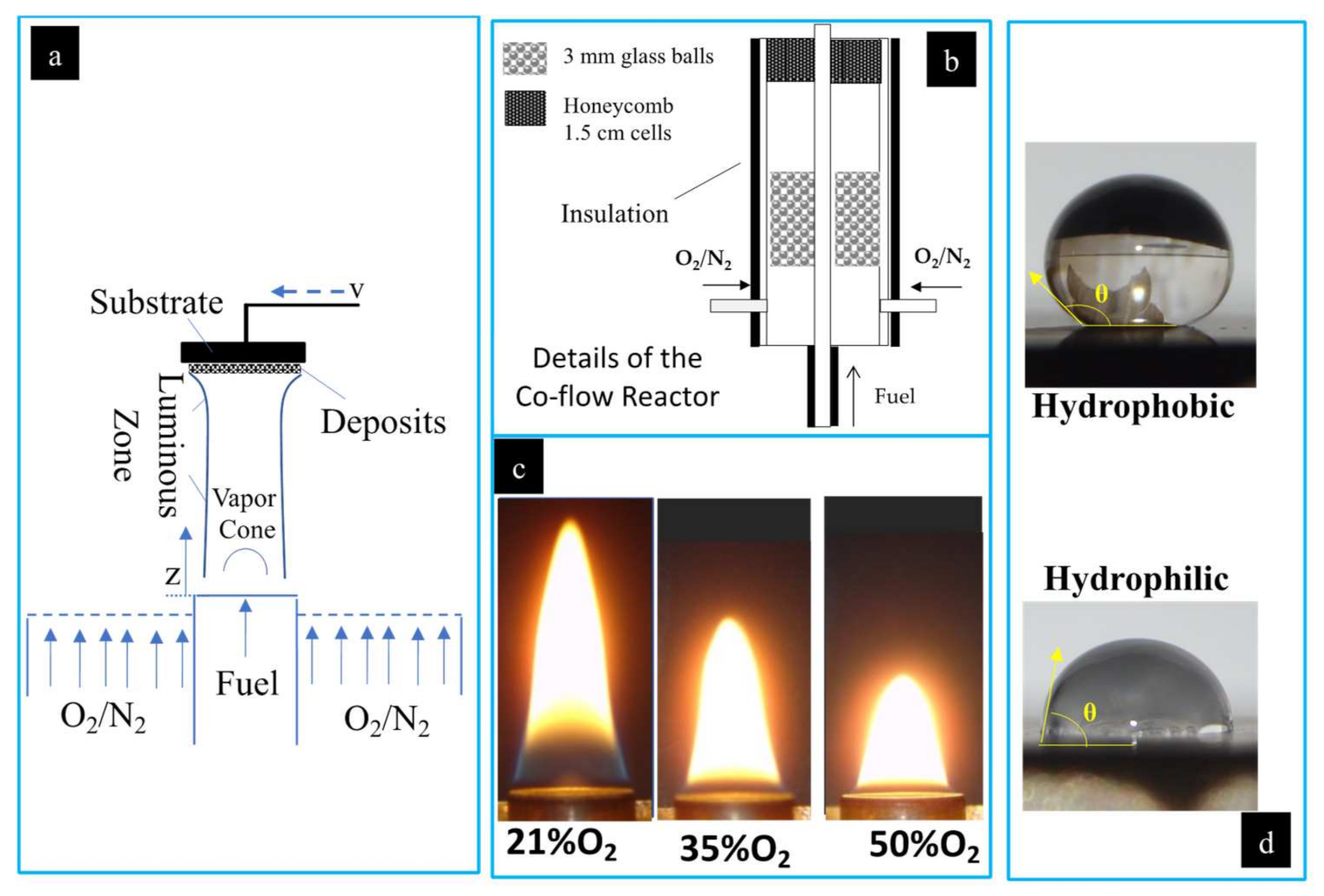

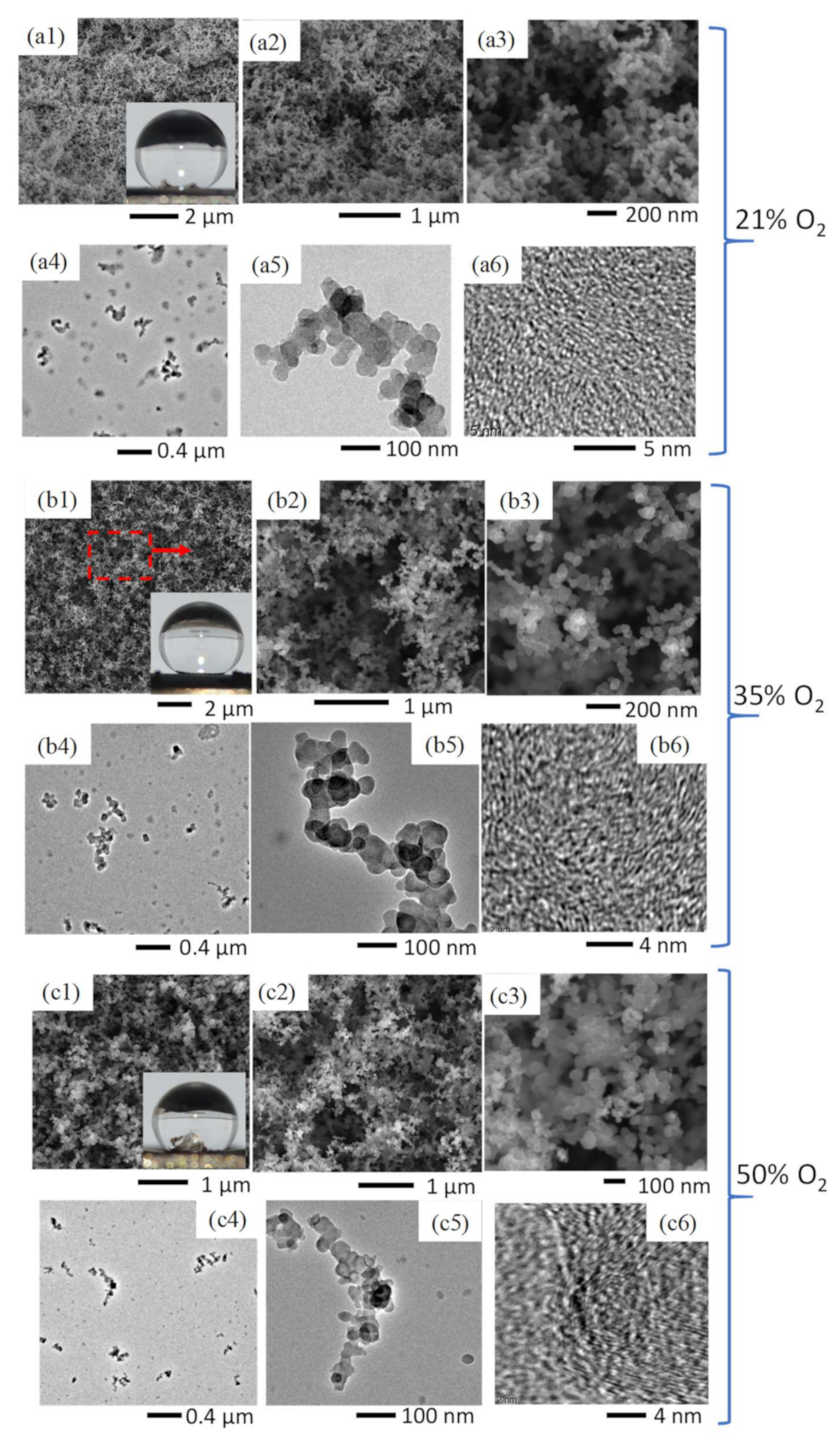

| Author | Flame Deposition Process | Study Findings | Fuel * |
|---|---|---|---|
| Naha et al. [26] |  |  | Ethylene |
| Yang et al. [21] | 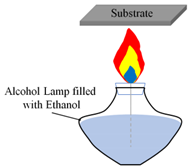 | 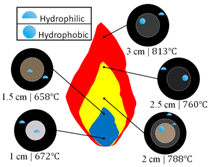 | Ethanol |
| Merchan-Breuer et al. [20] |  | 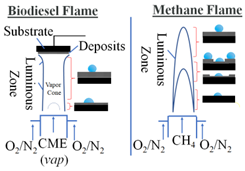 | Methane and CME |
| Xiao et al. [30] | 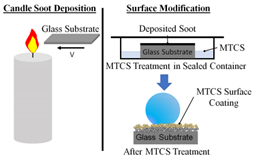 | 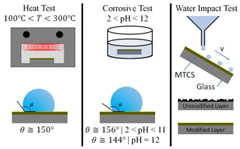 | Candle |
| Mansurov et al. [27] | 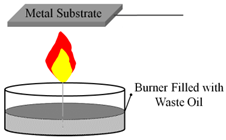 | 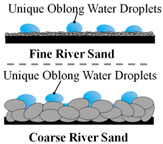 | Waste Oil |
| Esmeryan et al. [22] | 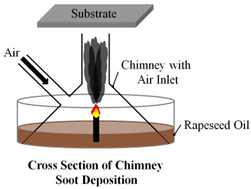 | 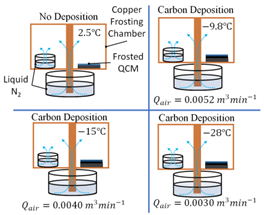 | Rapeseed Oil |
| Flame | Fuel | Oxidizer (% O2) | HAB (mm) | Residence Time (min) |
|---|---|---|---|---|
| Flame I | CME | 21 | 10, 12, 15, 20 | 5 |
| Flame II | CH4 | 21 | 50, 60 | 1 |
| Flame III | CME | 21, 35, 50 | ¾ Flame Height † | 5 |
Publisher’s Note: MDPI stays neutral with regard to jurisdictional claims in published maps and institutional affiliations. |
© 2022 by the authors. Licensee MDPI, Basel, Switzerland. This article is an open access article distributed under the terms and conditions of the Creative Commons Attribution (CC BY) license (https://creativecommons.org/licenses/by/4.0/).
Share and Cite
Merchan-Breuer, D.A.; Murphy, E.; Berka, B.; Nova, L.C.M.; Liu, Y.; Merchan-Merchan, W. Synthesis of Carbonaceous Hydrophobic Layers through a Flame Deposition Process. Appl. Sci. 2022, 12, 2427. https://doi.org/10.3390/app12052427
Merchan-Breuer DA, Murphy E, Berka B, Nova LCM, Liu Y, Merchan-Merchan W. Synthesis of Carbonaceous Hydrophobic Layers through a Flame Deposition Process. Applied Sciences. 2022; 12(5):2427. https://doi.org/10.3390/app12052427
Chicago/Turabian StyleMerchan-Breuer, Duncan A., Ethan Murphy, Benjamin Berka, Luis Carlos Mendoza Nova, Yingtao Liu, and Wilson Merchan-Merchan. 2022. "Synthesis of Carbonaceous Hydrophobic Layers through a Flame Deposition Process" Applied Sciences 12, no. 5: 2427. https://doi.org/10.3390/app12052427






